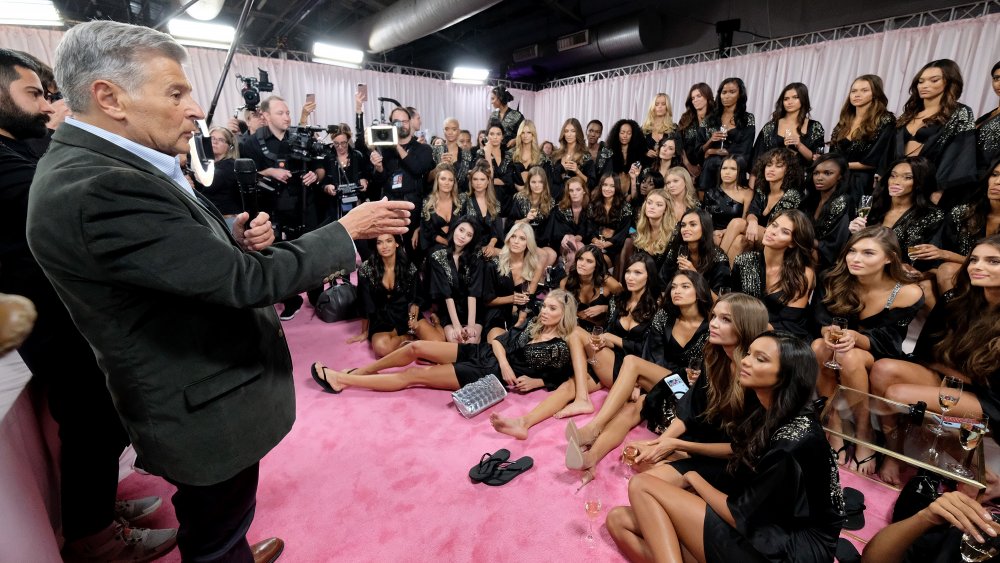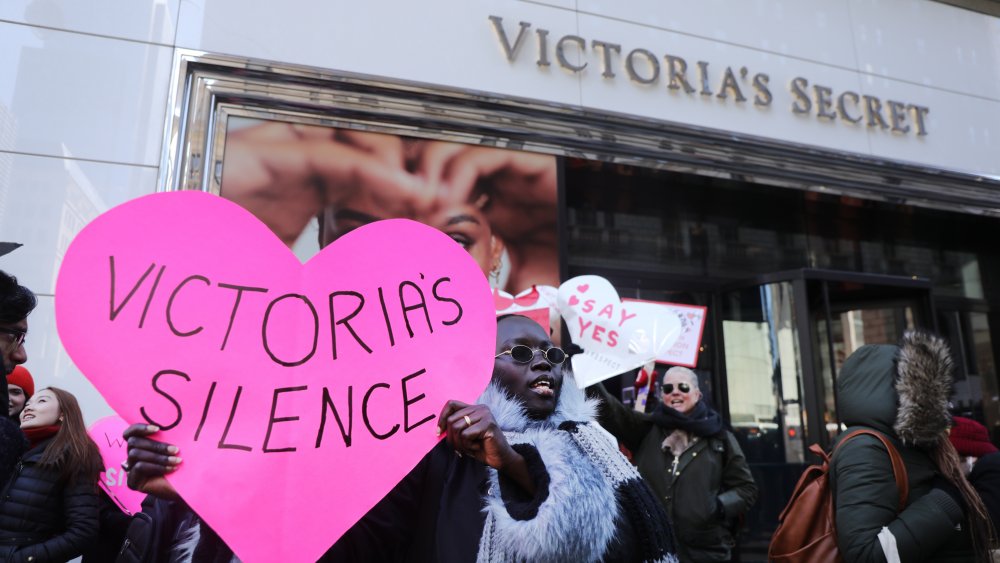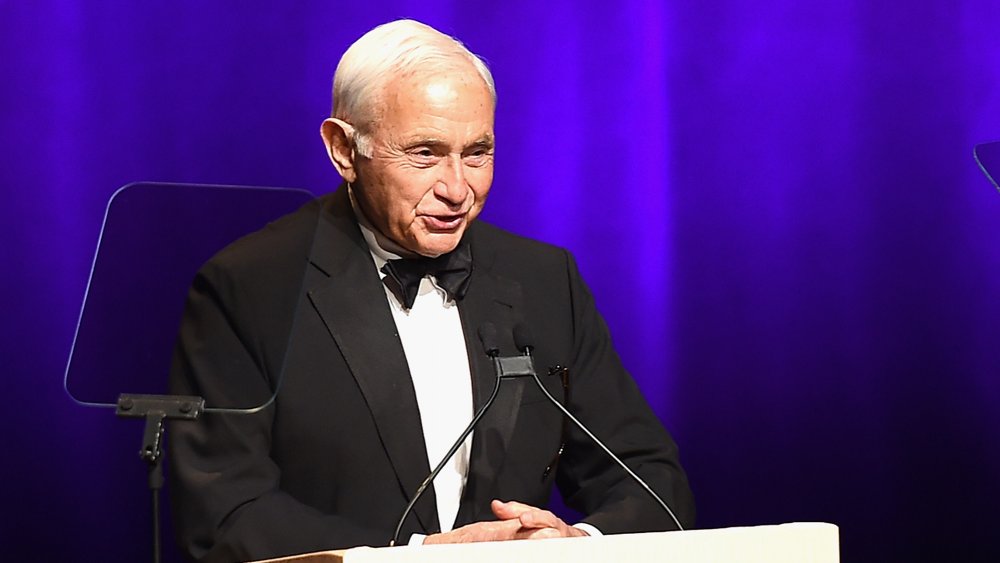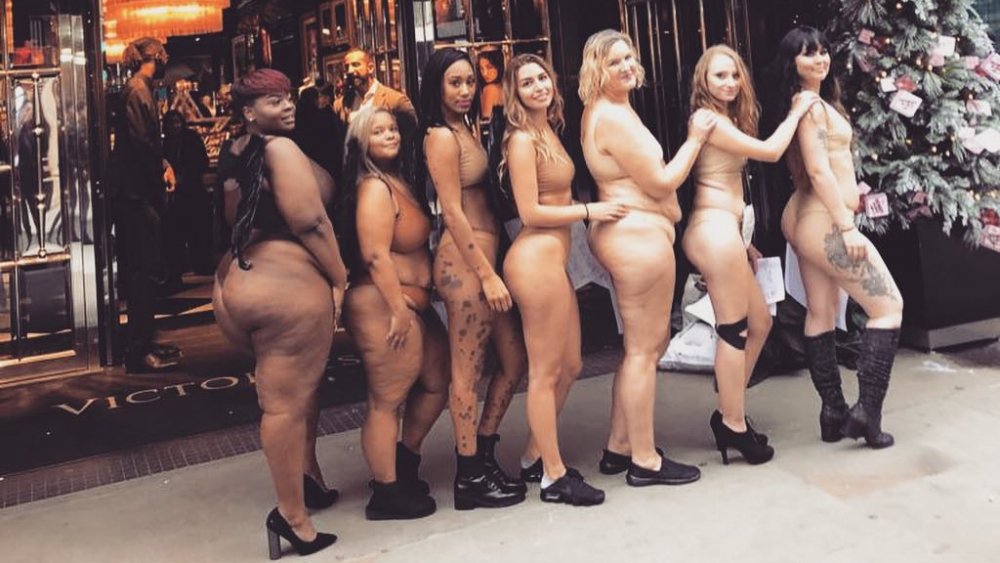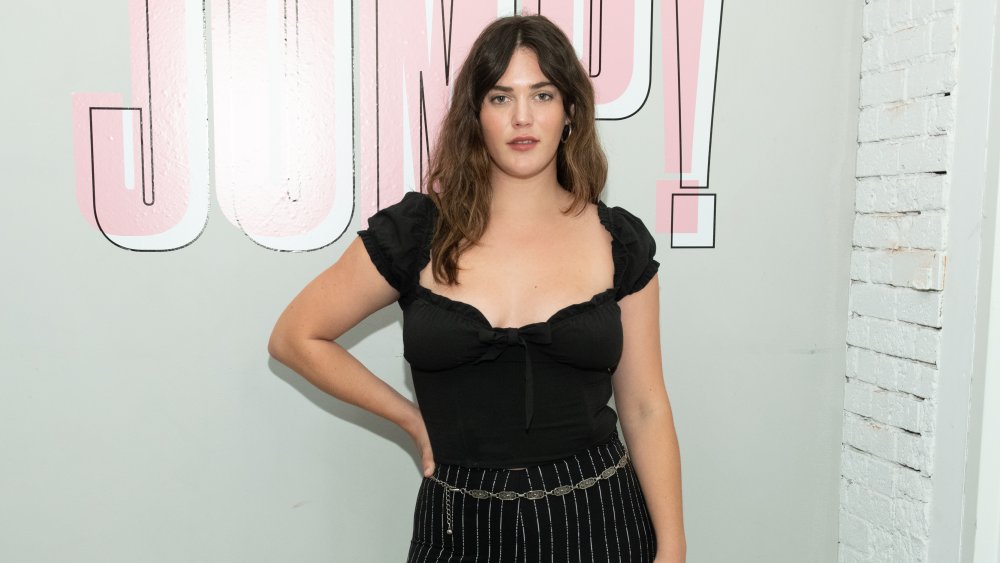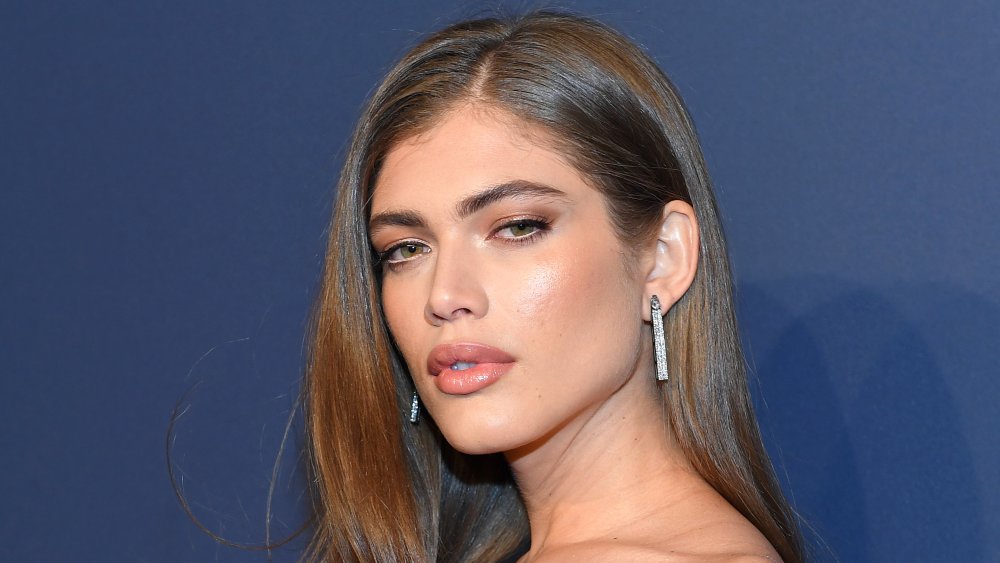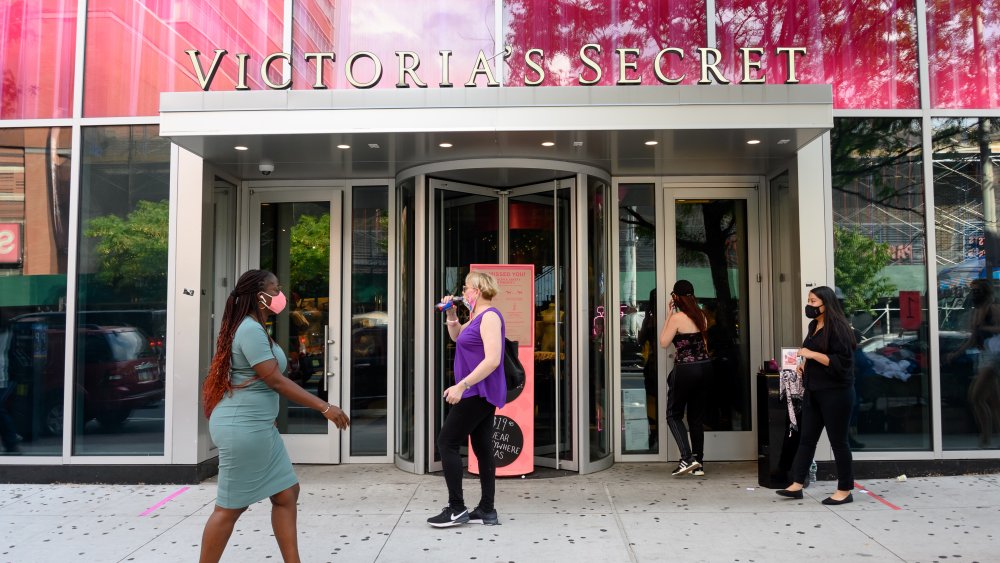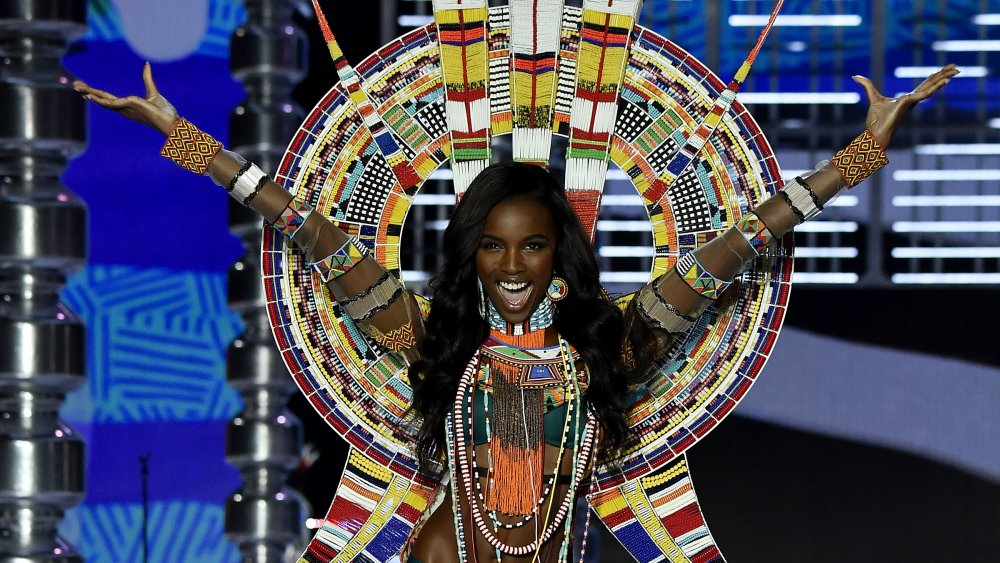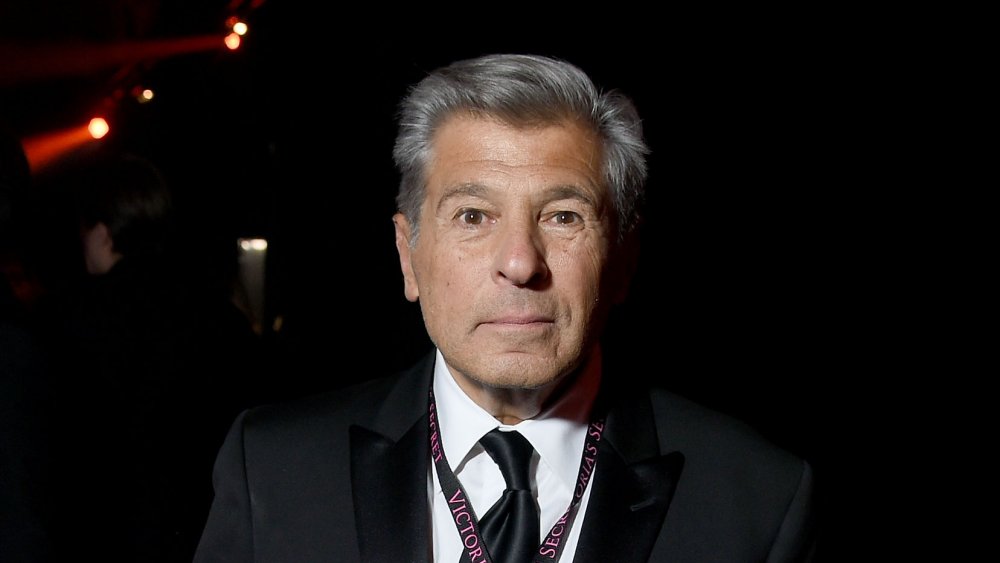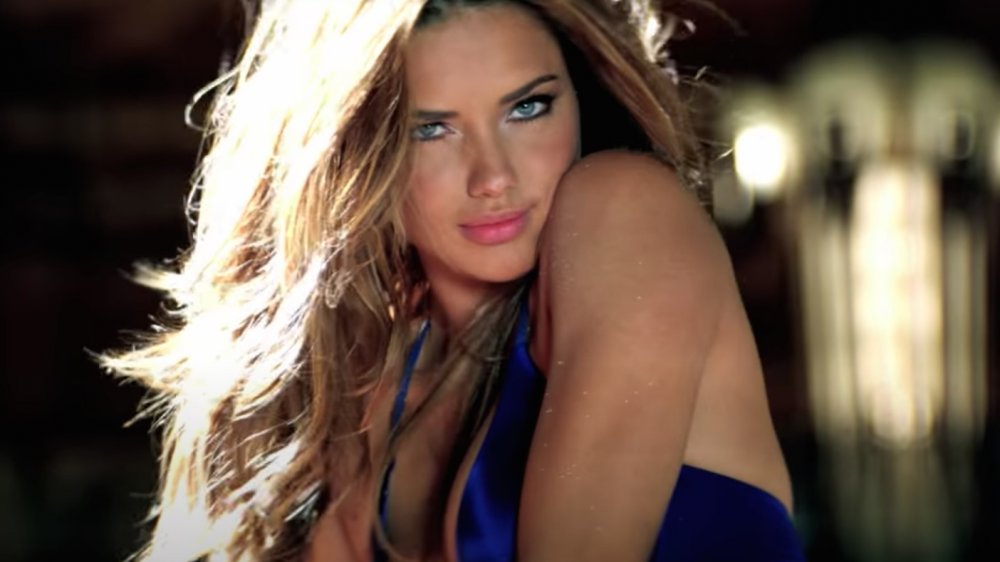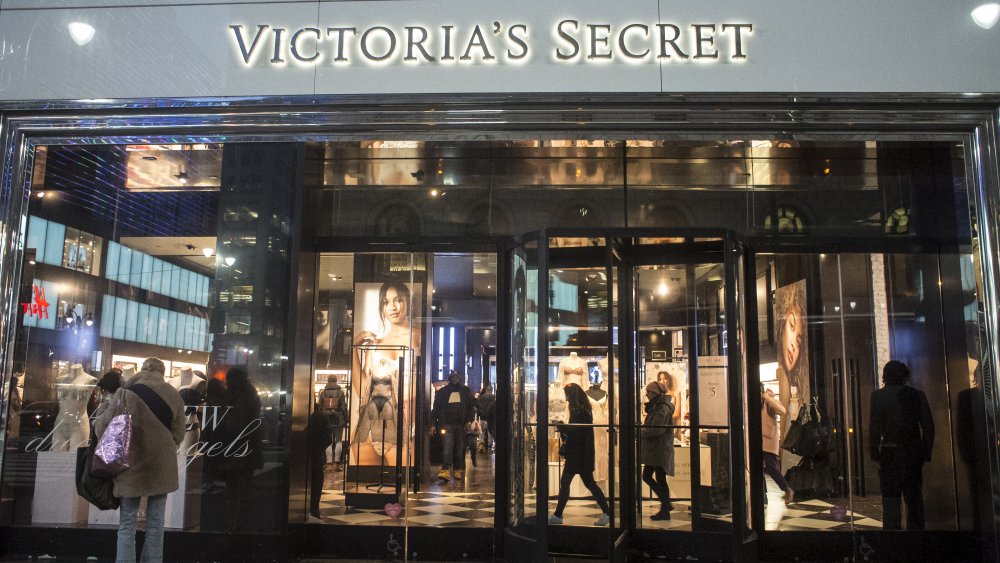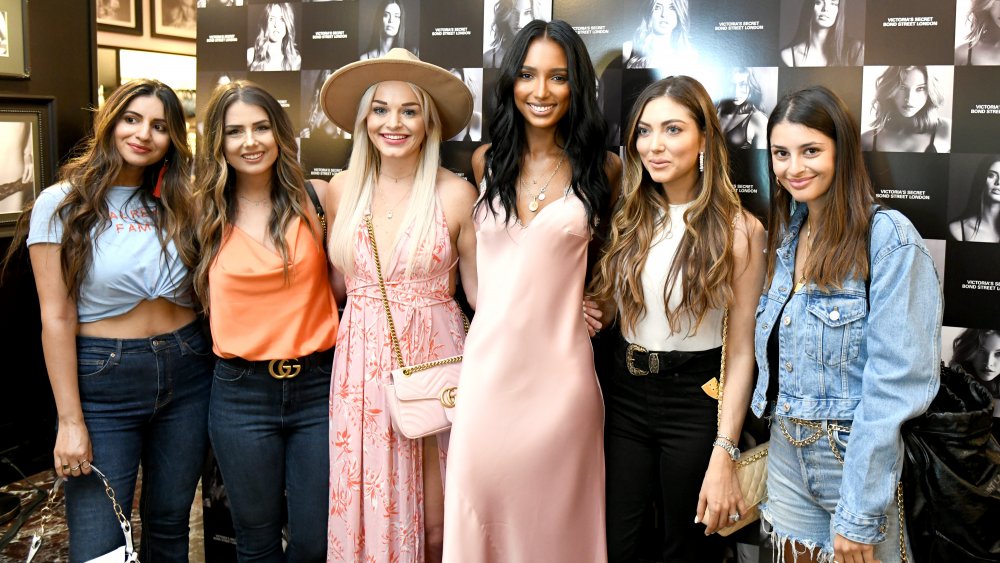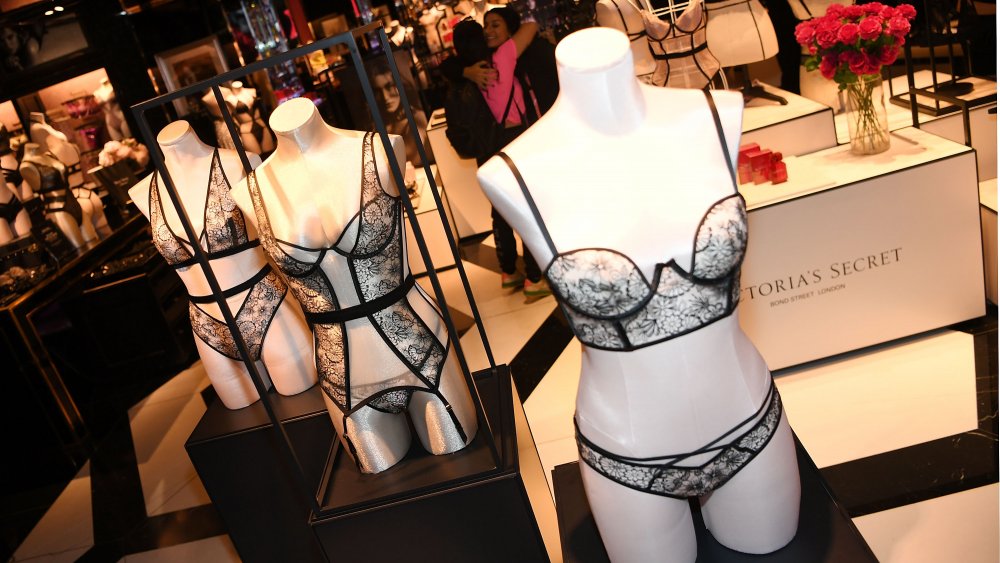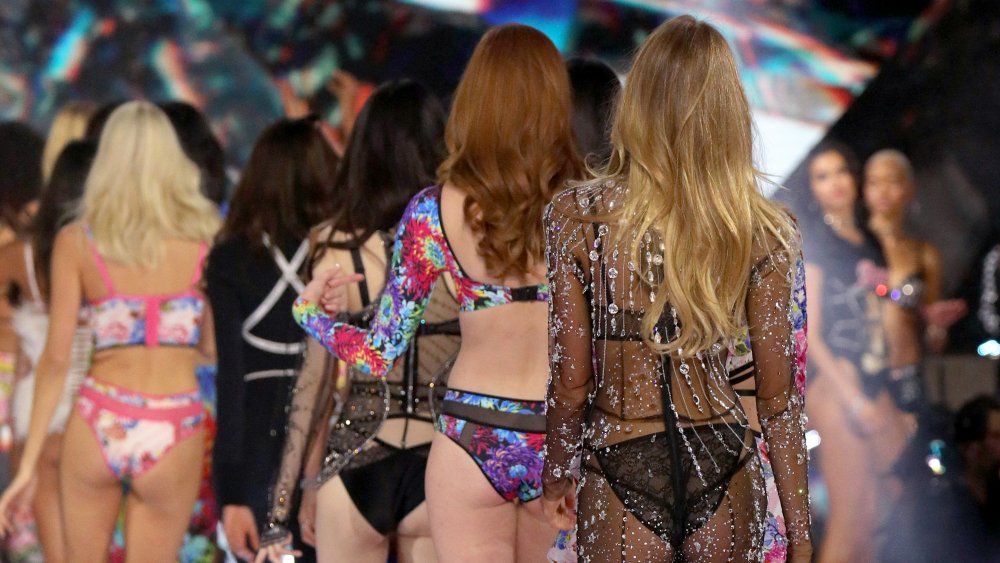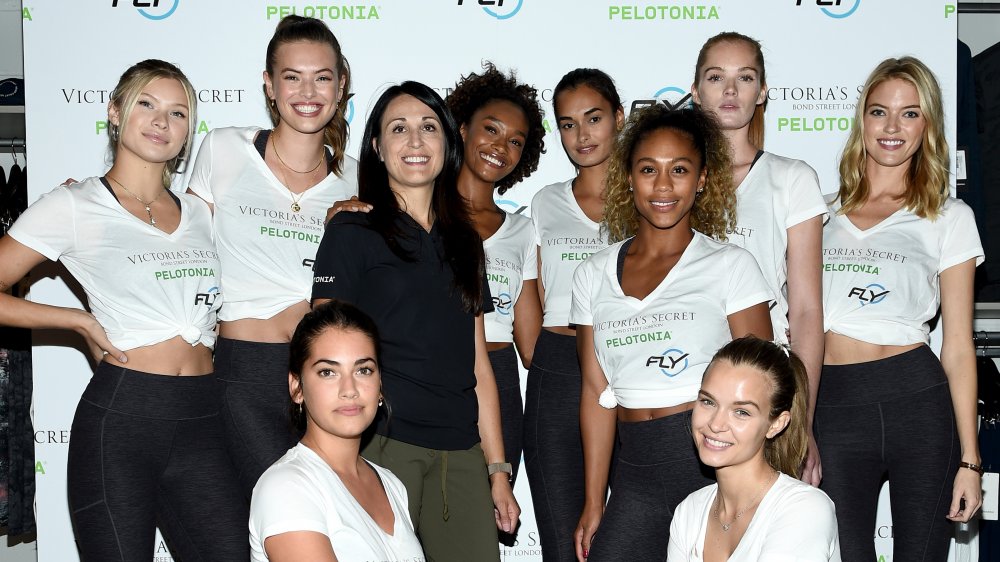Interesting Opinions About Victoria's Secret That Make You Think
There are some interesting opinions about Victoria's Secret that make you think. The lingerie retailer has been at the helm of the industry in the United States for decades, according to Business Insider. Founded in 1977 by Californian Roy Raymond, the initial intention for Victoria's Secret was for it to be a sensual sanctuary for straight men shopping with or for their partners, according to The Atlantic. Raymond wanted the brand to offer a more exciting experience than he'd had shopping in a mainstream department store, he reportedly told Newsweek in 1981. Then, to make it appealing to women as well, he invented "Victoria," a made-up British woman of the Victorian era; he mirrored the store after 19th-century British brothels.
Raymond opened up shop with a $40,000 loan from his family, though he probably didn't know then just how far that loan would take the company. Victoria's Secret soon became synonymous with sexy. Then in 1982, Leslie Wexner, who founded the retail empire L Brands, bought the business and transformed it into a bustling brick-and-mortar shop and catalog. The women's intimate-wear brand blew up in popularity in the late 1990s.
But it's since stirred some serious controversies.
Victoria's Secret was allegedly plagued by claims of sexual harassment within the company
In 2013, Slate summed up Victoria's Secret founder Roy Raymond's vision: "Raymond imagined a Victorian boudoir, replete with dark wood, oriental rugs, and silk drapery. He chose the name 'Victoria' to evoke the propriety and respectability associated with the Victorian era; outwardly refined, Victoria's 'secrets' were hidden beneath."
Alas, it seems that "Victoria" has more secrets than the company probably cares to admit. Mainly, an investigation by The New York Times dug up alleged sexual harassment within the company. According to the newspaper's interviews with more than 30 executives, employees, contractors, and models — as well as court filings and other materials — Ed Razek, the former CMO of Victoria's Secret, is alleged to have harassed numerous models. And, when those models spoke out to Leslie Wexner, the former CEO of Victoria's Secret, they reportedly faced retaliation. "This abuse was just laughed off and accepted as normal — it was almost like brainwashing," Casey Crowe Taylor, a former Victoria's Secret public relations employee told the outlet. "And anyone who tried to do anything about it wasn't just ignored; they were punished." Yikes!
Victoria's Secret's regret over alleged sexual harassment wasn't enough
After The New York Times published their exposé on sexual harassment claims against former Victoria's Secret CMO Ed Razek, people wanted answers. They were equally troubled by allegations that former CEO Leslie Wexner penalized anyone who spoke up about it.
In response to these pressing questions, Tammy Roberts Myers, a spokeswoman for Victoria's Secret's parent company L Brands, said that the company was "intensely focused" on "corporate governance, workplace and compliance practices," and that it regrets "any instance where [it] did not achieve this objective." Razek responded with an email of his own, declining to comment on the allegations. Instead, he reportedly wrote: "The accusations in this reporting are categorically untrue, misconstrued or taken out of context."
The conclusion reached by investigators Jessica Silver-Greenberg, Katherine Rosman, Sapna Maheshwari, and James B. Stewart? Victoria's Secret Angels are "'Angels' in hell." Relatedly, here's what it's really like to work as a Victoria's Secret Angel.
Victoria's Secret's efforts to include diverse bodies fell short
While Victoria's Secret is all about being sexy, many argue that the lingerie juggernaut doesn't promote sexiness in diverse ways; rather, the brand is largely blamed for pushing one definition of what that is: skinny and white.
In fact, in 2018, women of all shapes, sizes, and skin colors started stripping down and protesting outside of Victoria's Secret stores because of this, according to People. For example, advocacy group Love Disfigure (which calls for diversity across industries) and clothing brand Nunude collaborated to protest outside of a Victoria's Secret store in London. They were demanding more visibility of various body types on Victoria's Secret runways, according to an Instagram post. Other women shared online petitions on Instagram, calling out the brand for its lack of body and skin color diversity. The hashtag #WeAreAllAngels blew up with thousands of shares.
The protests came after Victoria's Secret's former CMO Ed Razek told Vogue that the Victoria's Secret fashion show is a "fantasy" and, for that reason, it doesn't intend on becoming more diverse.
Victoria's Secret's first plus-size model came way too late, and was part of a collaboration
Victoria's Secret made headlines when the brand sort of hired its first size 14 model. Bluebella, a U.K. lingerie brand renowned for its diversity efforts, collaborated with Victoria's Secret and hired Ali Tate Cutler for a campaign, according to E! News. Cutler told the outlet that she felt like Victoria's Secret was heading in the right direction with this move, and was finally starting to listen to its audience.
But not all Victoria's Secret fans were excited about the new-hire. Insider's Amanda Krause put it this way: "Victoria's Secret is being applauded for hiring its first plus-size model, but the brand doesn't deserve the praise." That's because they took decades to hire their first plus-size model, and they didn't even do it — Bluebella did, Krause wrote.
Cutler herself has even received backlash for an arguably fatphobic Facebook comment she made in 2016 that read, "Sorry, but I don't care about people's health who are fat." That prompted a Twitter user to respond in a tweet: "Not surprised this is the model that Victoria's Secret hired to be their first 'plus-size' model."
Victoria's Secret's choice to exclude trans women from their fashion show until after a fallout is pathetic
Former Victoria's Secret's CMO Ed Razek told Vogue in a now-infamous interview that the brand "doesn't need" to include transgender women in its fashion show. His reasoning? It's not part of the "fantasy." "It's a 42-minute entertainment special," he shared. "It is the only one of its kind in the world, and any other fashion brand in the world would take it in a minute, including the competitors that are carping at us." He added that they "carp" at the brand because they're the best in the business. Not surprisingly, Victoria's Secret came under fire for the comments, and later apologized for being "insensitive" on Twitter.
Arguably, Victoria's Secret later tried to redeem itself by hiring transgender model Valentina Sampaio, according to Elle. But to many, the move felt forced. Emma Elizabeth Davidson of Dazed said it bluntly: "[It] feels like an attempt to get the cash registers ringing amid falling sales as opposed to a genuine move towards diversity...It all feels just a little too late." Perhaps that's the real reason Victoria's Secret is closing so many stores.
Victoria's Secret could be far more LGBTQ+ friendly
It's no, err, secret (pun intended) that Victoria's Secret has stirred up a lot of controversy regarding its arguable lack of inclusivity. However, most of the time, the brand gets heat for its lack of plus-size models or its lack of skin color diversity among its models. But some Victoria's Secret customers have complained about the treatment they've received in stores — particularly customers who are part of the LGBTQ+ community.
In response to a tweet celebrating LGBTQ+ employees and customers posted on Victoria's Secret's Pink account, Twitter users rallied against the retailer. Some called out the lingerie brand for being disrespectful to LGBTQ+ employees, and one bisexual employee even said they'd had their fitting-room keys confiscated. Another Twitter user tweeted: "You can't pick and choose which letters you support. You excluded trans models," referring to former CMO Ed Razek, who told Vogue that Victoria's Secret didn't plan to include trans women in the show.
Victoria's Secret still makes women of color feel othered
Women of color are severely underrepresented in the fashion industry, according to Lindsay Peoples Wagner's survey of over 100 individuals, "from assistants and executives to stylists, models, and everyone else in between," she penned in an article for The Cut. And it doesn't seem like it's any different over at Victoria's Secret. While the lingerie company has hired models of color before, many argue that the brand hypersexualizes these women and appropriates their culture.
One Twitter user tweeted, in response to a series of photos of Victoria's Secret models in the 2017 fashion show, that Victoria's Secret is "still sexualizing traditional garments of black and brown people even though they get called out every year." She added that, "it's completely unnecessary because the actual underwear they're selling [is] basic," which she called "peak caucasity." Others on Twitter agreed that the models' traditional garments garnered more attention than the actual underwear in the 2017 show. Is that one of the real reasons Victoria's Secret later canceled their televised fashion show?
Victoria's Secret should have fired former CMO Ed Razek long before he quit
Former Victoria's Secret's CMO Ed Razek ultimately stepped down, but many critics of the controversial brand argued that he should have been fired long before he quit. In fact, petitions circled the internet calling for signatures to terminate him, just before former CEO Leslie Wexner released a memo that said Razek would be retiring, according to Fashionista. "It's clear from Ed Razek's dismissive and offensive comments that Victoria's Secret doesn't care about the concerns and needs of its customers — and has instead doubled down on Razek's objectifying and male-centered 'fantasy' of what a woman should be," one petition read. Another petition simply said: "Include more diverse models and sizes, and fire Ed Razek," adding that, "the company needs to move forward and get with the times or we will make sure it fails."
The petitions started cropping up after Razek made a comment to Vogue dismissing the inclusion of trans women in Victoria's Secret fashion shows. Ironically, Razek departed on the same day that news of Victoria's Secret hiring its first transgender model, Valentina Sampaio, started making rounds.
Victoria's Secret seems to be more focused on male viewing pleasure than what women actually want
Victoria's Secret was originally conceived of as a store for heterosexual men, where they can shop for lingerie with or for their partners, according to The Atlantic. After all, it was the brainchild of a white man, Roy Raymond, who was supposedly dissatisfied with his trip to a boring department store.
So it should come as little surprise that critics have argued that Victoria's Secret is more focused on male viewing pleasure than it is what women want. That's the case even today, decades since its founding. "Some of [Victoria's Secret's] ad campaigns, for example, seem more like a stereotypical male fantasy," The New York Times said of the lingerie juggernaut. This comment directly refers to a 2010 commercial directed by Michael Bay (the American film director and producer behind films like Transformers, The Rock, and The Purge), in which "scantily clad models strutted in front of helicopters, motorcycles, and fiery explosions." What does that have to do with bras, again?
Michael Bay has also had some seriously creepy moments that are worse than we thought.
Victoria's Secret's bra sizing is so off
Victoria's Secret prides itself on its bra-sizing capabilities. It even boasts an "angel bra guide" to help customers find their "perfect size" to feel more "comfortable, confident, and sexy." Except, not everyone who shops at the lingerie retailer feels very comfortable, confident, or sexy, according to writer Candace Bryan. "When I was 15, a Victoria's Secret employee told me I was a 36DDD. I wore that size for all four years of high school," she penned in an article for Mic. "Despite persistent discomfort...I never suspected I was wearing the incorrect size." She added that she simply trusted the sales associates, until she later learned that she was actually a 30G, thanks to being fitted at "more upscale lingerie stores" like Journelle and Linda's.
Bryan isn't alone in her experience. In fact, multiple women told Hello Giggles that they were sold the wrong bra sizes at Victoria's Secret stores. Some even said that the sales associates would sell them any size just to sell bras. Others were convinced that the brand just doesn't carry a wide variety of sizes. So don't go shopping at Victoria's Secret until you read this.
There are not nearly enough women at the helm of Victoria's Secret
Victoria's Secret was founded by a man in 1977, according to Slate. Then, in 1982, another man (Leslie Wexner) stepped in and bought Victoria's Secret to make it a more appealing place for women (you know, the clientele). Yet another man (former CMO Ed Razek) was brought onboard to try to boost the company's image. Fast forward to a 2019 investor meeting, and another man — the brand's CEO, John Mehas — said he wanted the company to be "by her, for her." Anyone sensing the issue here?
Journalist Elizabeth Segran pointed out the elephant in the room. "Victoria's Secret's leadership is predominantly male," she wrote in an article for Fast Company. "And almost all of the people who spoke in the investor meeting were men."
But the company has always been run by men — the same men who consistently try to create female-driven plans for the company without female input, according to Business of Fashion. But what investors (and consumers) really want isn't a forced agenda to appear more inclusive, according to Adage. Clearly more women are needed at the helm of Victoria's Secret!
Victoria's Secret is failing women with bigger breasts
Some large-busted women don't seem to love what Victoria's Secret has to offer them. In fact, writer Candace Bryan wondered in a Mic article if the lingerie juggernaut is failing busty women. "While my smaller-chested friend was fitted into a 34C, describing the fitting as 'careful' and 'thorough,' my experience was something else entirely," she wrote. "The same fitter haphazardly held the measuring tape up to my chest and handed me a 34DD. When I said it was too small, she returned with what I expected: a 32DDD." Bryan added that the fitter left her to attend another customer, even though the bra didn't come close to fitting her well.
In a post on XOJane (republished on In Style), a former Victoria's Secret employee admitted to lying about bra sizes to customers. The reason? She wanted to avoid having to tell them that Victoria's Secret didn't carry their sizes. "I didn't have [it in me] to tell her we didn't have anything that would fit, so I totally copped out: I lied and told her she was a 38B," she revealed.
Victoria's Secret perpetuates eating disorders
What do Victoria's Secret models eat in a day? Victoria's Secret models are notoriously thin, and some have opened up about their struggles with eating disorders. Model Erin Heatherton, for example, told Time about her difficulty trying to lose weight, recounting how she'd exercise twice a day. Still, she said her body "just wouldn't do it," which depressed her to the point that she considered skipping meals altogether.
Additionally, Victoria's Secret model Bridgette Malcolm also told Harper's Bazaar that, "unknowingly, [she] was battling an eating disorder and chronic anxiety that would soon lead to a ruined digestive system" — all because she was trying to "succeed."
Being thin doesn't mean that someone has an eating disorder (nor should that ever be assumed!). But peddling a nearly unobtainable body type can be dangerous for women, even though bodies are just plain different. "I think it's sad," dietitian and eating disorder expert Marisa Sherry told CBS News. "Victoria's Secret was always a company that highlighted women's bodies and curves with sex appeal. But, over the last few years, they have been criticized for accepting thinner and thinner models."
Victoria's Secret has improved its image, but now it just feels forced
Victoria's Secret is certainly including a more diverse array of women in its marketing these days, as you can see on its Instagram page. However, to many, the effort just feels forced. Vice contributor Annie Lord still calls the brand out of touch when it comes to women's desires. "The issue is not that Victoria's Secret is too 'sexy,' but more that it portrays just one, narrow version of 'sexy,' which represents only a very small portion of women and has been conjured up by men," she wrote. "The VS angels exemplify the idealized, impossible form of femininity society constantly tells women to strive toward."
Lord added that the company pushes a "hyper-feminine, skinny version of beautiful" that's "undoubtedly attractive," but not the only kind of beauty out there. She calls the women who represent Victoria's Secret "clean-eating ambassadors who nibble on flax seeds and do Bikram yoga." And, frankly, that's just not all of us. Now we understand why Karlie Kloss stopped modeling for Victoria's Secret.
